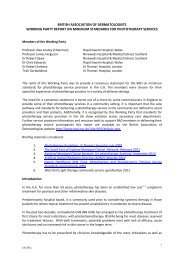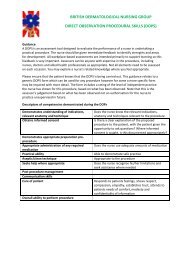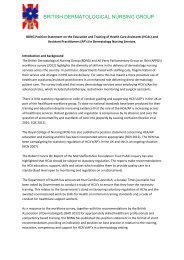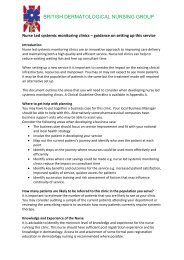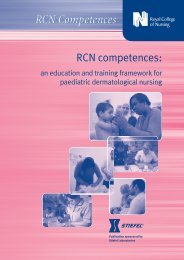Improving outcomes for people with skin tumours including melanoma
Improving outcomes for people with skin tumours including melanoma
Improving outcomes for people with skin tumours including melanoma
You also want an ePaper? Increase the reach of your titles
YUMPU automatically turns print PDFs into web optimized ePapers that Google loves.
A function of the LSMDT is to audit management and in particular to<br />
ensure that wider/re-excisions have been adequately per<strong>for</strong>med. As<br />
<strong>with</strong> BCC/SCC audits, this should be presented quarterly to the MDT.<br />
The LSMDT should also receive quarterly audit data from any<br />
clinicians working in the community (Table 3).<br />
<strong>Improving</strong> Outcomes <strong>for</strong><br />
People <strong>with</strong> Skin Tumours<br />
<strong>including</strong> Melanoma<br />
Organisation of <strong>skin</strong><br />
cancer services<br />
Core membership of the LSMDT<br />
The LSMDT should include the following.<br />
• Designated lead clinician. A designated lead clinician (normally<br />
a consultant dermatologist) who will take overall responsibility<br />
<strong>for</strong> the service.<br />
• Dermatologists. There should be a designated lead and ideally a<br />
deputy lead, both <strong>with</strong> a special interest in <strong>skin</strong> cancer, and any<br />
dermatologist involved in <strong>skin</strong> cancer care should attend the<br />
MDT meeting.<br />
• Skin cancer clinical nurse specialists (CNS) (as defined by the<br />
Manual of Cancer Services 23 ). Patient advocacy and provision of<br />
in<strong>for</strong>mation and support <strong>for</strong> patients and carers are crucial<br />
aspects of this role. The CNS will play a key role in<br />
communication between the patients and the different<br />
specialties involved in management and must have a high level<br />
of communication skills. She or he should be able to provide<br />
practical support such as advice postoperatively. The CNS will<br />
also have an important role in the identification of patients’<br />
psychosocial needs and will advise on appropriate referral. The<br />
CNS may, if suitably trained, carry out a range of related service<br />
activities such as minor surgery, <strong>skin</strong> cancer surveillance and<br />
follow-up clinics in parallel <strong>with</strong> an appropriately trained doctor.<br />
3<br />
• Histopathologists. Histopathologists should take a lead role in<br />
<strong>skin</strong> cancer. Pathology reports should include all the in<strong>for</strong>mation<br />
required by the current Royal College of Pathologists minimum<br />
dataset <strong>for</strong> the relevant cancer. 24 The histopathologists engaged<br />
in <strong>skin</strong> cancer diagnosis should participate in an appropriate<br />
external quality assessment (EQA) scheme and demonstrate<br />
evidence of continuing professional development (CPD) relevant<br />
to <strong>skin</strong> cancer. The lead histopathologist should attend over 50%<br />
of MDT meetings. Other histopathologists reporting <strong>skin</strong> cancer<br />
should be able to demonstrate some MDT activity.<br />
23 Department of Health (2004) Manual <strong>for</strong> cancer services. Available from: www.dh.gov.uk<br />
24 Royal College of Pathologists. Standards and datasets <strong>for</strong> reporting cancers. Available<br />
from: www.rcpath.org<br />
Guidance on cancer services: <strong>skin</strong> <strong>tumours</strong> <strong>including</strong> <strong>melanoma</strong><br />
53




